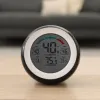The yellow scourge is upon us. Everywhere around Atlanta, a thick blanket of dust covers houses, cars, roads, and – when they dare venture out into it – people.
It’s pollen. Pine pollen, to be sure. And it’s a sign that spring has arrived.
Around here, when you can see pine pollen, it means many other kinds of pollen are also afoot. And pollens aren’t the only allergens that rear their heads in spring. With warmer weather comes more humidity, a catalyst for mold growth. High indoor humidity also provides a comfortable habitat for dust mites, which can aggravate allergies.
So, how can you allergy-proof your indoor air with all this going on?
You may never make your indoor air perfect, but you can certainly make it better. Much better.
If you’re concerned about pollen, humidity, and other warm-weather allergens infiltrating your home’s air, here’s a step-by-step process for minimizing their impact on your health.
1. Get a better air filter
Your current air filter likely has one or more of these issues:
- Fits awkwardly in the filter housing, allowing air to bypass the filter
- Isn’t designed to capture airborne allergens that circulate throughout your home
- Prevents airflow inside your HVAC equipment and ducts; this is a big problem for anyone who buys those high-MERV 1″ filters from big box stores.
You want to avoid these problems. A better air filter can get you there, provided you get the right kind. At the very least, you should replace your current air filter with a media filter.
Media filters have more surface area than standard 1″ filters. This allows them to effectively filter air without reducing airflow. You get the same high MERV values that you get from the 1″ pleated filters, but without the airflow problems that make you uncomfortable. These filters capture nearly all of the airborne allergens that make you sneeze and cause your eyes to itch, and they do so without impacting HVAC performance.
Another plus: You only have to replace them once or twice each year.
For even more serious filtration, consider a carbon-coated media filter (it’s a media filter with better odor control) or even a HEPA system. HEPA filters provide medical-grade air filtration. They’re the best of the best when it comes to filters, capturing even the tiniest of contaminants that may otherwise enter your lungs.
2. Seal your air ducts
It’s so important to seal your air ducts — and to seal them well.
To understand how leaky ducts impact indoor air quality, think about how your HVAC system works. There’s a big fan inside the indoor unit. This fan brings air into the system via your return ducts. Then it blows conditioned air (cooled or heated, depending on the season) out through the supply ducts.
But when those ducts are leaky – and its return ducts are the biggest offenders when it comes to indoor air quality – the unit’s fan isn’t just pulling air from your living space through the ducts. It’s pulling air in through the leaks, too.
And the leaky ducts live in, um… less-than-clean spaces. Attics or crawlspaces, typically.
Basically, leaky air ducts let humid, dusty, and possibly mold-laden air enter your home. Needless to say, this air is not good for your allergies! By sealing the leaks, you can prevent these allergens from entering your living space. Your HVAC system will bring in the air directly from your home and only from your home.
Note that really dirty ducts may need to be cleaned.
If your ducts have been leaky for many years, the inside of your ducts may be very dirty. In some cases, they need to be cleaned. Check out our article about duct cleaning to determine whether that’s something you need.
3. Zap microbes with a UV light
In spring and summer, your air conditioner’s indoor coil stays wet, 24/7. That moist environment is perfect for microbial growth, and rest assured: microbes will proliferate on your AC’s indoor coil.
Then, when your AC is running, the fan will blow those bacteria into your living space. Following steps 1 and 2 above will reduce microbial growth on the coil because getting a better air filter and sealing duct leaks will prevent the coil from getting very dirty. Microbes won’t grow on the coil in as great a number because they’ll have less dust and dirt to feed on.
But they’ll still grow on it.
Enter the HVAC UV light. It’s essentially a special lamp that lives inside your indoor unit and bathes the coil in ultraviolet light. This light kills the remaining microbes, so they never enter your indoor air.
4. Circulate fresh air
Fresh air helps control odors in your home and reduces the negative health impact of off-gassing consumer products, VOCs, and other contaminants. For many, these odors aggravate allergies throughout the year.
When most people think about letting in the fresh air, their first thought is opening a window. But you shouldn’t do that.
In spring and summer, that “fresh” air is laden with pollen and humidity. It will make your indoor air less fit to breathe, not more. However, you definitely should circulate fresh air throughout your home. But how?
In our climate zone, the two best options are:
Ventilating whole-house dehumidifiers that bring in fresh air, filter it, and remove humidity at the same time. These devices interface with your ductwork and help your air conditioner remove humidity from the air. When you attach a fresh air intake, they do double duty by pushing fresh air from the outdoors into your home.
Energy recovery ventilators (aka ERVs) that remove air from your home and introduce fresh air from the outdoors at the same time. They also filter the air. An ERV is not a dehumidifier, but it will transfer humidity from the incoming air to the outgoing air as it cycles.
5. Consider taking bigger steps
Implementing steps one through four above should take you from bad or so-so air to above-average air quality that reduces the symptoms of allergies. But there are other things you can do… if you’re willing.
Modify your habits
Sometimes, we create air quality problems. We don’t mean to, but it happens.
For example, do you leave your shoes on when you come in from outside? If you don’t take them off, you’re tracking environmental allergens, like pollen, all over your home. The same goes for when you sit on a pollen-covered bench and then plop down on the sofa.
Or what about your pets? How clean are they – and where inside your home do they sit and sleep?
Even when it’s hard to change all of your habits that impact air quality, there are things you can do to mitigate the damage. For instance, investing in a vacuum cleaner with a HEPA filter helps ensure that when you do clean your house, you’re getting rid of virtually all of the environmental allergens that have made their way onto your floor.
Get rid of curtains and carpet
Draperies are dust havens that don’t get cleaned very often. If you must keep your curtains, at least use the kind you can wash in the washing machine. You’ll be more likely to clean them. Even better: replace all curtains with shutters that you can easily dust.
Carpets, likewise, are a poor flooring option for allergy sufferers. When it’s time to replace your carpet, go hardwood instead!
Air seal your home
We already explained how duct leaks allow contaminants into your living space. Gaps and cracks in your ductwork allow dust and dirt to enter your HVAC system.
Well, the same thing happens with the gaps and cracks throughout your home. Humidity, dust, pollen, and other environmental allergens infiltrate your air through these gateways, exacerbating problems with allergies. When you have a lot of air leakage in your floors or ceiling – most people do, by the way – you may even be breathing the fiberglass dust from your crawlspace or attic. That’s not good.
Will your air filter capture a lot of this bad stuff? Sure. But is it better to prevent it from entering your home in the first place? Absolutely.
A blower door-guided energy audit of your home will reveal all the biggest areas of air infiltration. Then you can set about sealing those leaks and improving air quality.
Upgrade your HVAC system
We’re not saying you should get a new HVAC system just to improve air quality, but newer HVAC systems do include features that can make the air your air cleaner. When it’s time for a new system, you should consider upgrading to one of these units.
Variable speed and two-speed HVAC systems do a better job keeping indoor air clean when compared to standard systems. That’s because they usually operate at a low speed, which aids in humidity removal. Lower indoor humidity means a less hospitable environment for dust mites and microbial growth.
So, yes. A more efficient HVAC system can improve indoor air quality.
Remember to take it one step at a time
In the end, taking action on any of these suggestions should improve your allergies this spring and throughout the year. Is it better to follow all the steps? Of course, it is.
But even something as simple as getting a better air filter or sealing your ducts can go a long way toward making you more comfortable inside your home.
Need help deciding what to do or how far you should go toward allergy-proofing your Atlanta-area home? Give us a shout! Our team will listen closely to your concerns and help you make the right move.






